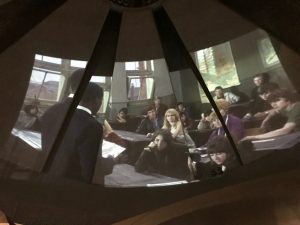By Chris Jeppesen //
On the evening of Monday 22 January 2018, SESC was delighted to welcome an audience of almost fifty to watch the 1967 film adaptation of E. R. Braithwaite’s semi-autobiographical novel To Sir With Love [1959], an event made even more of a pleasure by screening the film onto Murray Edwards College’s spectacular Dome. With some of the audience reclining on beanbags and others enjoying a glass of wine and popcorn, we settled back to enjoy Sidney Poitier’s portrayal of Braithwaite’s time teaching in an East End secondary modern school during the 1950s.

Edward Ricardo Braithwaite was born in 1920 in British Guiana (present day Guyana) and first came to England in the early 1940s after studying in the US. Having served in the RAF during the Second World War, he tried to find work as an engineer upon demobilisation but was repeatedly prevented from doing so through racial discrimination. Teaching offered Braithwaite a temporary solution and he started his first post at St George-in-the-East Secondary School in 1950. Here he worked under one of the most prominent and successful pioneers of progressive education, Alex Bloom, whose philosophy emphasised ‘disciplined freedom’ where pupils were encouraged to express themselves freely through active participation in school life, rather than just passively receiving from their teachers. [1]
Book and film both follow a fairly conventional narrative, summarized by one reviewer as ‘class almost breaks teacher’s heart, teacher is about to give class as a bad job, then teacher suddenly discovers he has done a little good after all and tears up his resignation form’. Upon arriving at the school, Braithwaite took charge of the ‘top class’, still celebrating driving-out their previous teacher and preparing to leave school behind at the age of 15. Initial exchanges were characterized by antagonistic mutual incomprehension: Braithwaite shocked by the manners, demeanour, and appearance of his surly, disengaged charges; they determined to challenge his authority and break his will.
However, as Braithwaite comes to realise that to connect with his pupils and open their minds he must treat them as adults not children, mutual respect builds. Throughout, the interplay of race and class are central. Daily discrimination convinced Braithwaite that the colour of his skin meant that despite his cherished sense of Britishness, he would never be accepted as a Briton, even though the working-class community he encounters is far removed from his own middle class upbringing and sense of self as a cosmopolitan, professional man. Yet by the end he finds fragile optimism in his pupil’s ability to reflect upon, and potentially to challenge, the entrenched attitudes of older generations. [2]
Released almost a decade later, James Clavell’s film adaptation updates Braithwaite’s account from 1950s austerity to Swinging ‘60s London, promising ‘A story as fresh as the girls in their minis… As cool as their teacher had to be!’ Filmed at North Quay Secondary School near Cable Street, the film captures the cramped conditions and dated facilities experienced by many secondary modern pupils in inner city schools built before the war and never intended for the demands of mass secondary education.
Yet this backdrop is in stark contrast to the ‘in’ teenagers who fill it, with their bobs, mop-tops, and miniskirts; Lulu both stars and sings the film’s title track and The Mindbenders play beat tracks at the school dance. While Clavell remains fairly loyal to Braithwaite’s description of classroom exchanges, he strikes a more optimistic tone overall that reflects the prevailing sense of possibility, especially amongst the young, during the mid-1960s – as Poitier reminds his class: ‘they belong to the luckiest generation there ever has been, one that may learn to lead a life without fear’ (not something Braithwaite felt prepared to proclaim in the 1950s).

Responses to the film were decidedly mixed. Audiences on both sides of the Atlantic flocked to see it at the cinema. In the US it took over $42million dollars at the box office, where Lulu also spent four weeks at Number 1 in the charts with Billboard Magazine’s song of the year. Yet, even as Ebony magazine tipped it for Oscar success, many reviews struck a more ambivalent tone. The New York Times described it as a ‘cozy, good humoured and unbelievable little tale’ but complained that it repeatedly dodged the most controversial and important questions of racial prejudice, teenage rebellion, and authority in schools. This is certainly fair. Clavell softened much of the racial prejudice that Braithwaite described in the book and omitted entirely his relationship with a white female teacher (Ebony speculated that this was done so not to antagonise American audiences)
The British press tended to be even more critical. Under a headline that read ‘Please Sir may I leave the cinema?’, The Daily Express’ reviewer complained that the film was ‘entirely predictable’ and that while it ‘means well…its sugar coated, rose tinted solution of our educational problems is just so much pi R squared in the sky.’ Another review in The Times similarly bemoaned its entirely unrealistic depiction of school life and Cockney-fied caricature of the East End. Many felt frustrated by its over sentimentalized portrayal of the relationship between pupils and teacher, and that by failing to engage more seriously with the maelstrom of debate then surrounding the structure and aims of secondary education Clavell produced little more than another example of romanticised school-based escapism. [3]
Amongst the project team re-watching the film sparked another set of questions around the highly gendered assumptions and complacent misogyny that proliferate in book and film. Whereas the casual racism displayed by the students towards ‘Sir’ is at least problematized, the gendered expectations regarding what and how working-class girls and boys should be taught in the final few months before leaving school were so omnipresent they don’t even merit comment. Miniskirts and mascara aside, the film suggests a very limited set of possibilities open to female working-class school leavers at this time. As the project moves forward, a key part of our research will be to explore the ways in which class and gender, aswell as race, were played out in relation to one another within school settings across the period and how they shaped both educational experiences and a sense of what was possible after school.
It is our hope that this will be the first of many screenings of school-based films from the postwar period and would welcome any suggestions you might have – perhaps If or Kes next? We hope that those who joined us for the screening found it as enjoyable and thought provoking as we did and would love to hear your thoughts, so please do leave a comment.
References
[1] E. R. Braithwaite, To Sir With Love (London: Bodley Head, 1959); Caryl Phillips, ‘Introduction’ to To Sir With Love, Vintage Braithwaite edition (London: Random House, 2005)
[2] Alan Dent, ‘Eroding the colour-bar’, Illustrated London News, 9 September 1967, p. 33
[3] ‘To Sir, with love’, Ebony, 22:6 (April 1967), pp. 68-74; Bosley Crowther, ‘Poitier meets the Cockneys’, New York Times, 15 June 1967; Ian Christie, ‘Please Sir may I leave the cinema?’, Daily Express, 8 September 1967, p. 4; John Russell Taylor, ‘To Russia with tears’, Times, 13 July 1967, p. 8